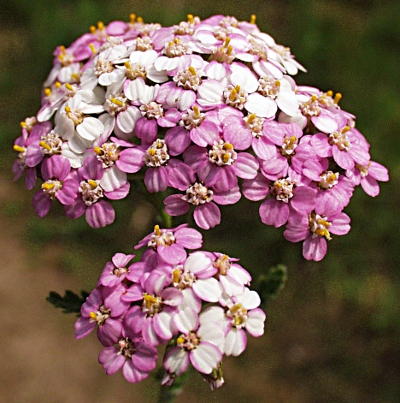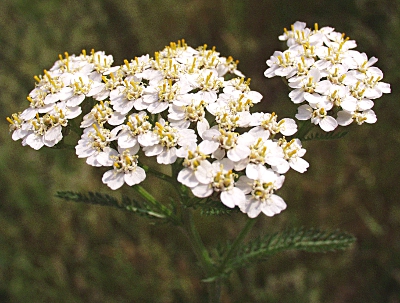Species group common yarrow |

The flowers are white, pink – or in this case – two-colored (probably by crossbreeding of a garden plant)
- Achillea setacea,
- A. collina,
- A. roseoalba,
- A. pannonica,
- A. pratensis,
- A. sudetica
and the common yarrow (A. millefolium ssp. millefolium)
The latter species is in Emsland very common, but it is noted that it probably composed of several small clans, which have not yet been described in detail.
In order to distinguish the plants of the group, one have to look closely. A. collina for example differs from A. millefolium ssp. millefolium by leafy branches below the center of the stems and from basal leaves, that mostly do not reach half the length of the whole plant, but this species is very rare. A. pratensis is characterized among other things by its "grassy" growth: several plants of the same height in one spot.
Within the species group and even with yarrow outside of this, also with garden forms, hybrids may arise. Some hybrids are to be identified only by genetic analysis.
The common yarrow is an ancient medicinal plant that has similar anti-inflammatory effects as chamomile. A tea made from yarrow (herb and flowers, 1–2 teaspoons, brew for 15 min.) helps against colds, stomach and intestinal complaints, gynecological problems and is antispasmodic. Baths with dried yarrow flowers (a good handful, pour boiling water over them, brew for 20 min., add to the bath) help against chapped skin and inflammation, hemorrhoids and is even supposed to inhibit the symptoms of old age.

Filigree stem leaf of A. millefolium
The common yarrow indeed is not rare in Germany, but who wants to collect and dry larger quantities, he should better grow it in his own garden, if it is not already there grows by itself. The seeds are collected in the previous year and sow them next spring on a dry, sunny location. It is even better to draw them in a garden pot, because the milfoil quickly spreads by stolons what can be really annoying.
The plants are harvested during the flowering period. The very hard stems require a knife or scissors. The bottom 10 cm are the hardest and not to use. Then the plants are laid out to dry in a thin layer or bundled and hanged in a shady, well-ventilated place. Dried plants are also well suited as a decoration, e.g. in dry flower arrangements. Those who does not have a garden can purchase tea from or with yarrow commercially.
Young leaves of yarrow are edible and can be used as the addition e.g. in salads, cream cheese, soups and sauces. Older leaves have a bitter taste and can be used as a spice. Extracts of yarrow are found in some herbal liqueurs or bitters.
Historical publications
Dioscorides (1st century AD.) describes the Stratiotes chiliophyllos as small shrub with leaves like the feathers of a young bird. They would most likely resemble those of the wild cumin, but the umbel is denser than in this, because it had little stalks at the top, where the umbels were arranged as with the dill. The flowers were white and it would grow in dry places. Dioscorides recommended the plant against bleeding, wounds and fistulas.

The flower heads of the common yarrow
are arranged
in umbel-like corymbs
Hildegard of Bingen (1098–1179) wrote about the "Garwa" that it had special and fine forces against wounds. A wound you should wash with wine first, then squeeze lightly cooked yarrow in a cloth and place the cloth on the wound. If the wound begin to heal, one should give the yarrow directly to the wound.
Against internal injuries she recommended powdered yarrow take dissolved in warm water. Following the occurrence of an improvement she advised taking the powder in warm wine.
Against three-day fever (infantile disorder triggered by herpesviruses) she recommended to drink boiled yarrow with twice the amount polypody every three days in good wine.
Also in the herb book by Leonhard Fuchs (1543) the "Garb" is mentioned. From it there were two genders, one with white flowers, and one with skin-colored ones, otherwise there would be no difference between them. The seeds were similar to those of chamomile. He even recommended the yarrow for wounds and ulcers, and it would be used daily by surgeons.